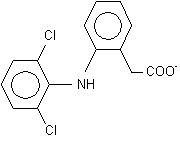Use of nonsteroidal anti-inflammatory drugs (NSAIDs) is a common and effective treatment for osteoarthritis. Despite their proven efficacy, side effects such as gastrointestinal bleeding and ulcer formation are a problem, especially in elderly patients. NSAIDs inhibit the synthesis of prostaglandin by blocking the action of cyclooxygenase (COX) and its two isoforms, COX-1 and COX-2. The COX-1 isoform maintains the integrity of the gastrointestinal mucosa; thus, gastrointestinal toxicity occurs with NSAID use because of the inhibition of COX-1. Rofecoxib is one of a new class of NSAIDs that specifically inhibit COX-2 and should, theoretically, cause fewer gastrointestinal side effects. Cannon and colleagues compared the efficacy and safety of rofecoxib with that of diclofenac, a traditional NSAID.
Patients eligible for the randomized, double-blind study had to be at least 40 years of age and have confirmed clinical and radiographic evidence of osteoarthritis. Following a medication washout period, patients were randomized to receive rofecoxib in a dosage of 12.5 mg or 25 mg daily, or diclofenac in a dosage of 50 mg three times daily. All patients received a matching placebo for each study medication. Open-label acetaminophen was allowed for pain control. Follow-up visits were conducted at regular intervals for the 12 months of the study, approximately every two to four weeks for the first three months and then every seven weeks for the rest of the study period. At each visit, patients completed a previously validated osteoarthritis index, and patients and physicians completed an assessment of disease status. The primary end points of the study were pain with walking, patient assessment of response to pain and physician assessment of disease status. Secondary end points included assessment of pain, stiffness, joint mobility and joint tenderness. Laboratory studies, including hematology and blood chemistry studies, were obtained at each follow-up visit.
Initially, 784 patients were enrolled in the study. Of that number, 448 completed it. Patients dropped out at virtually the same rate across groups because of lack of efficacy or adverse events caused by the study drugs. Mean response for patient assessment of response to therapy was similar across groups. Treatment responses for all primary end points occurred within the first two weeks of the study. Additional statistical analysis of the three primary end points indicated no significant interaction with treatment in various subgroups, including location of joint, previous osteoarthritis medication (NSAID or acetaminophen), age or sex. Nausea, diarrhea and heartburn were the most frequently reported adverse gastrointestinal effects, and these occurred equally across groups. Symptoms of gastric or duodenal ulcer developed in four patients taking rofecoxib and in three taking diclofenac. No episodes of gastrointestinal bleeding were reported, nor were there significant changes in serum creatinine levels or blood pressure. Eleven patients taking diclofenac had significant increases in hepatic transaminase levels compared with zero in the rofecoxib group.
The authors conclude that the COX-2 inhibitor rofecoxib at either study dosage is as effective as standard dosages of diclofenac in the treatment of osteoarthritis. Rofecoxib was well tolerated, with few gastrointestinal side effects and no reported adverse renal events.
EDITOR'S NOTE: Rofecoxib and its competitor, celecoxib, have been aggressively marketed to physicians and consumers. Theoretically, the gastrointestinal safety profiles of these drugs make sense; however, acetaminophen, which is even safer, remains the first-line drug of choice for the treatment of osteoarthritis in most patients. The cost of the COX-2 inhibitors, which ranges from $3 to $5 per day, is a significant issue.
COPYRIGHT 2000 American Academy of Family Physicians
COPYRIGHT 2000 Gale Group



